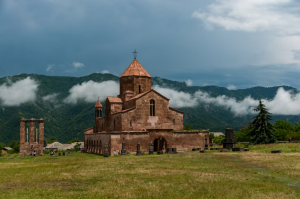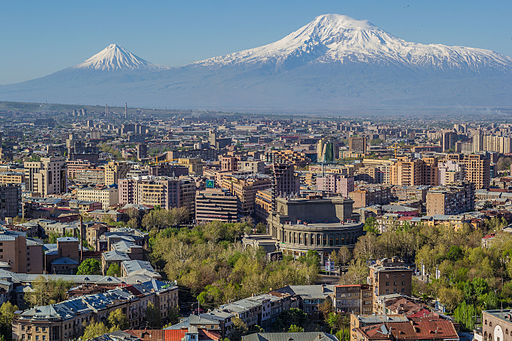My Armenia: A Story of Backgammon, Old Ladas, and Wine in a Fanta Bottle

By Sharon Paige��
The sound I remember most from Yerevan is the sharp clack-clack-clack of backgammon pieces. You hear it drifting from shaded courtyards and sidewalk cafes, a constant, rhythmic pulse under the city’s hum. It���s the sound of time being passed, not rushed. I spent my first afternoon just sitting with a five-cent coffee, watching two old men play a game with the intensity of chess masters, their faces weathered like the city’s pink tuff stone. No one hurried them. No one cared that I was just sitting there. That���s when I started to get it.

Mount Ararat��and the��Yerevan��skyline in spring. The��Yerevan Opera Theatre��is visible in the center. Photo by ������������ ���������������� (Serouj Ourishian), CC BY-SA 3.0 https://creativecommons.org/licenses/by-sa/3.0, via Wikimedia Commons https://commons.wikimedia.org/wiki/File:Mount_Ararat_and_the_Yerevan_skyline.jpg
I came to Armenia to see rocks���ancient monasteries, specifically. I had a checklist. But Armenia doesn���t care about your checklist. It pulls you into its own rhythm, a rhythm measured in backgammon games and long, slow coffees.
My apartment was near the Vernissage market, and on Saturday it exploded into this wonderful, sprawling chaos. It smelled of old leather, dried herbs, and grilled meat. I was digging through a box of Soviet-era pins���little enameled rockets and portraits of Lenin���when I saw her. A girl, maybe my age, with dark, tired eyes and hands stained with ink, sitting behind a small table of t-shirts.
This wasn’t your usual tourist junk. I���m a graphic designer, and I can spot good work from a mile away. Her��screen printed t-shirts��were minimalist, powerful. She was taking ancient symbols���the kinds you see carved into 5,000-year-old stones���and making them feel modern, alive. I picked up a soft grey one with a stylized eternity symbol.
“I love this,” I said.
She looked up, startled, as if pulled from a dream. “Thank you,” she said, her English hesitant. “My grandmother says it looks like a broken pretzel. She wants me to print shirts with ‘I Love Armenia’ and a big heart.” She rolled her eyes, and in that moment, we weren’t a tourist and a vendor; we were just two young women who understood the battle between tradition and your own creative spirit. Her name was Anahit. I bought the broken pretzel shirt. It’s my favorite thing I own.

To see the rocks on my list, I needed a driver. The hotel quoted me a fortune. So I walked down the street to a taxi stand and found Levon, a man with a magnificent mustache and a sky-blue Lada that looked like it had personally witnessed the fall of the Soviet Union. The passenger door didn’t open from the outside, so he had to lean over and pop it open for me every single time. The radio only got one station, which played a constant stream of heartbreakingly beautiful Armenian folk music.
We rattled our way out of the city towards Geghard Monastery. The last part of the road was gravel, and the Lada groaned in protest. Geghard isn���t just built; it’s clawed out of a cliff face. Levon told me to put my hand on the wall inside. The stone was cold, damp, and felt like it was humming. In one of the main chambers, a woman started singing. Not a performance, just a quiet, personal prayer. Her voice filled the entire stone dome, wrapping around us, and I felt tears welling up. I wasn’t sad. I was just��� full. Full of the history, the sound, the cold stone on my palm.
The next day, the trip to Tatev Monastery was pure, stomach-in-your-throat terror. You get there on a cable car called the “Wings of Tatev,” which soars for what feels like an hour over a gorge so deep it looks like a crack in the planet. I gripped the railing, trying not to look down, and watched a tiny old woman across from me calmly knitting, not even glancing out the window. She���d probably done this a hundred times. For her, it was a bus. For me, it was a near-death experience that ended at a fortress of faith perched at the edge of the world.
The best part of the trip, though, wasn���t a monastery. It was the meal Levon arranged at his cousin Armine’s house near Lake Sevan. Her garden was a tangle of tomato plants and chickens that scattered when we walked in. We sat at a long wooden table while her husband grilled pork over a fire of dried grapevines. The smell was intoxicating.
Armine brought out the wine. It was in a reused plastic Fanta bottle, and the wine itself was a cloudy, pinkish color. I braced myself. It was, without a doubt, one of the most delicious things I have ever tasted. It was light and fruity and alive. We ate smoky pork and dolma and drank wine from the Fanta bottle until the sun went down over the lake, talking about our families, our lives, our hopes. No one spoke perfect English, and I certainly don’t speak Armenian, but we understood each other completely.
I left Armenia with a full heart, a camera full of pictures of rocks, and that grey t-shirt. But the real souvenirs are the memories that feel like they belong to me: the clack of backgammon pieces, the sound of Levon’s Lada, the taste of wine from a Fanta bottle. It���s a place that doesn���t just show you its history; it lets you become a small part of it.
The post My Armenia: A Story of Backgammon, Old Ladas, and Wine in a Fanta Bottle appeared first on We Said Go Travel.
We Said Go Travel
We Said Go Travel is a global community of over sixteen hundred writers with articles from every continent.
Stories are shared with photos and video from a perspective of the transformative power of travel. We Said Go Travel has hosted live and online events as well as travel writing contests around the world. ...more
- Lisa Niver's profile
- 57 followers



